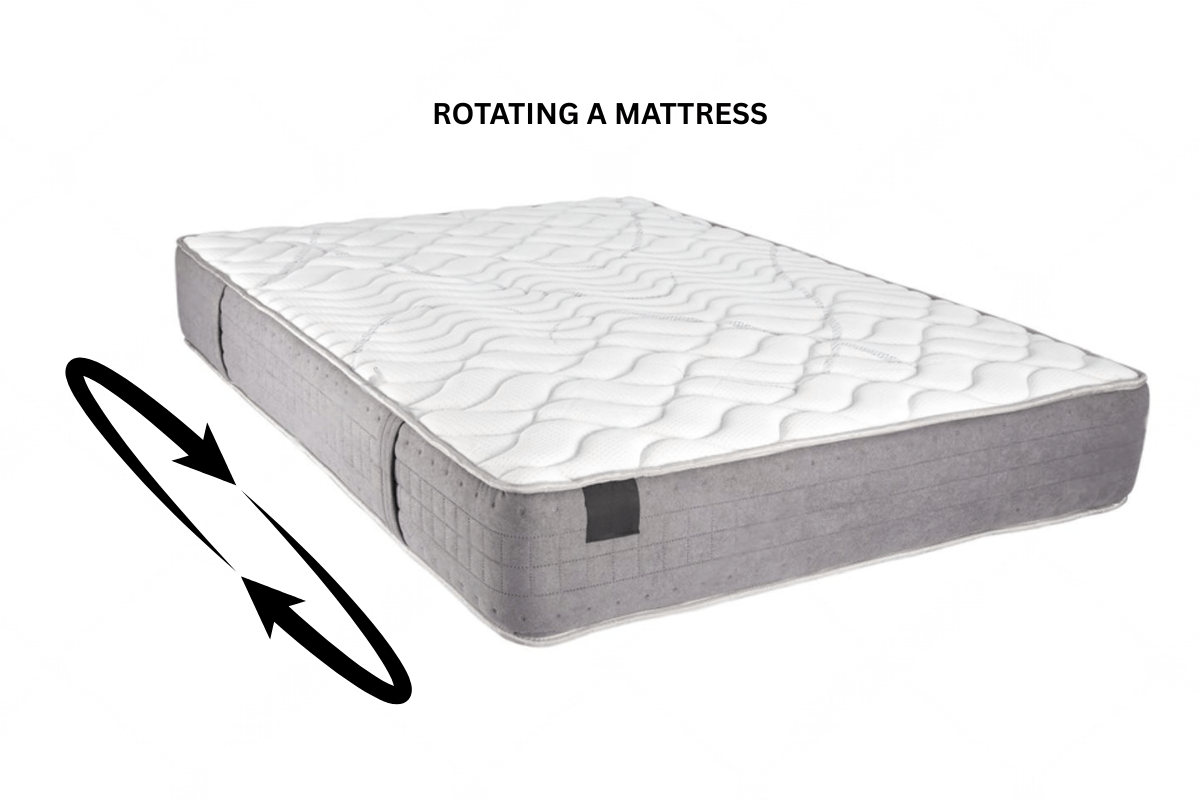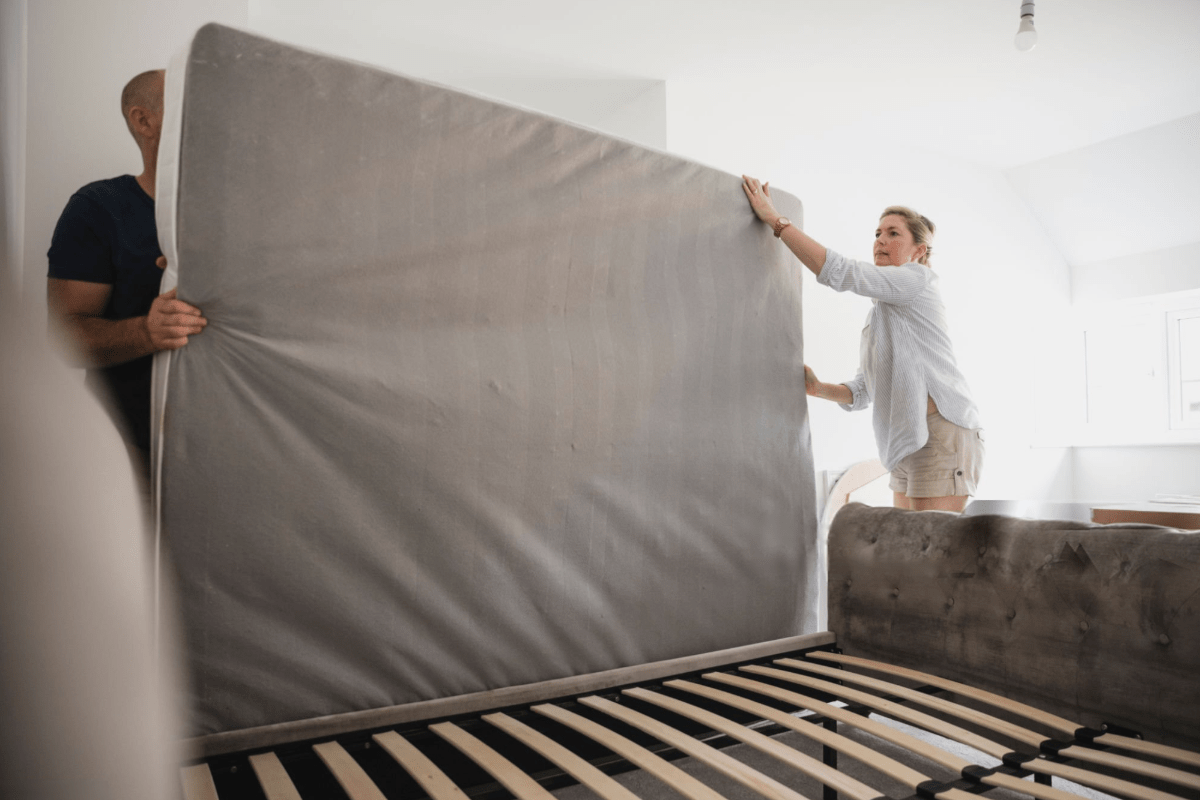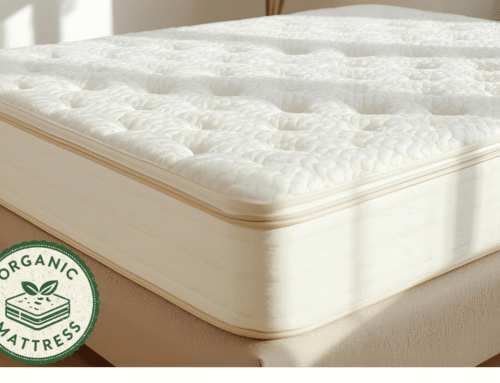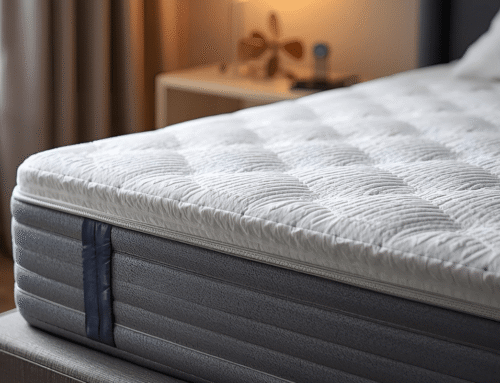Memory foam mattresses have become popular because they adapt to the body’s shape, ease pressure points, and support a more restful sleep. Over time, uneven wear causes sagging or indentations that affect comfort and support. Regular rotation preserves the mattress’s shape and feel by distributing wear more evenly.
Rotating a memory foam mattress means turning it 180 degrees so the head end becomes the foot end. People usually sleep in similar positions each night, which causes certain areas to wear out faster. Rotating the mattress balances the wear, extending its comfort and overall lifespan.
When you don’t rotate your memory foam mattress regularly, pressure points become worn down, which can lead to sagging and discomfort. Areas exposed to repeated use are also more likely to trap moisture and develop stubborn stains over time. This can make it necessary to learn how to get stains out of memory foam mattress easily, how to get urine out of it, and how to dry it.
Regular rotation helps prevent these issues by spreading out wear and exposure, and it’s also important to understand what happens if you sleep on a memory foam mattress before 48 hours and what is a gel memory foam mattress, since both impact how you care for your bed from the start.
But how often should a memory foam mattress be rotated? Experts recommend rotating every three to six months to maintain the mattress’s performance. Let’s break down the best way to rotate and how it helps preserve comfort for years to come.
Key Takeaways
- Rotate your memory foam mattress every 3–6 months to prevent dips and sags while keeping it comfortable for longer.
- If you sleep on the same side, rotation spreads out the pressure and slows down the formation of soft spots.
- Pay attention to signs like lumps, uneven areas, or morning aches, as these indicate it’s time to turn your mattress.
- Avoid flipping your memory foam mattress unless the label clearly states it’s double‑sided—rotation alone is enough.
- Mark your calendar as a reminder, as this simple habit extends your mattress’s lifespan and helps you save money.

Why Rotate Your Memory Foam Mattress?
Rotating a memory foam mattress encourages even wear, preventing dips or soft spots from forming in the areas used most. Without rotation, these uneven areas can cause discomfort and affect sleep quality over time. Regularly turning the mattress also promotes better airflow and helps to keep it feeling fresh and comfortable.
Certain memory foam mattresses include zoned support or unique constructions that might affect whether rotation is recommended. It’s important to follow the specific advice from the mattress manufacturer to avoid unintended damage. Generally, though, rotating can help preserve the mattress’s shape and support for longer.
This simple habit extends the mattress’s useful life by reducing pressure points and maintaining consistent firmness. Proper rotation helps maximize how long a memory foam mattress lasts and can delay the need to replace it. While no mattress lasts forever, consistent care like rotating ensures you get the most comfort and durability from your investment.
Rotating doesn’t fix every issue, but it’s an easy way to keep the sleeping surface balanced. Over time, this can contribute to a more comfortable and restful night’s sleep.
How Often Should You Rotate a Memory Foam Mattress?
Rotating a memory foam mattress every three to six months is a common recommendation among sleep experts, usually about two to four times a year. New mattresses benefit from more frequent rotations during the first year, around every two to three months,so the foam settles evenly and wears more uniformly. After that initial period, rotating every six months tends to be enough to maintain comfort and support.
Sleeping habits also affect how often a mattress should be rotated. If someone tends to sleep on the same side consistently, or if a couple stays mostly on one side, that area experiences more pressure and could wear out faster. In those cases, rotating more often can help extend the mattress’s life and keep it feeling balanced.
Keeping track of rotation schedules can be tricky, so setting a reminder or marking a calendar works well to stay consistent. It doesn’t have to be complicated, but regular rotations prevent uneven wear and help maintain the mattress’s comfort over time.
Signs It’s Time to Rotate
Lumps or sags appearing in a mattress often signal uneven wear and affect sleep quality. Waking up with neck or back pain results from a mattress that no longer provides proper support. These physical cues indicate the mattress fails to maintain its original comfort.
An uneven or less supportive surface causes discomfort during the night, and visible indentations in the areas used most show the mattress compresses unevenly. This kind of wear means the mattress requires attention to extend its lifespan.
Rotating the mattress helps distribute pressure more evenly across its surface, which delays further damage and improves comfort even if the mattress is not brand new. Paying attention to these signs prevents ongoing aches and promotes better rest. In addressing such wear and support issues, it’s helpful to consider what thickness of memory foam mattress is best and how to fix the dip in it.
If the mattress feels too soft or warm, adjusting how to make a memory foam mattress firmer and how to make it cooler can help improve comfort alongside rotation.

Tips for Rotating Your Memory Foam Mattress
Before rotating your memory foam mattress, it’s important to know how to move, compress, and store it properly to prevent damage and make handling easier. Ensuring you have enough space and using the right techniques can protect the mattress and reduce strain during the process. This also includes understanding how long a memory foam mattress takes to expand and how to handle it during that initial phase for proper setup.
Removing all bedding and pillows is the first step before rotating a memory foam mattress. Clearing the surface ensures the mattress can be handled easily and prevents any damage to linens. Having enough space around the bed is important for smooth movement during the process.
Rotating the mattress 180 degrees, swapping the head and foot, helps even out wear over time. Since memory foam mattresses tend to be heavy, it’s wise to ask for help from a friend or family member to avoid strain or injury. Flipping the mattress isn’t recommended because memory foam is designed to support weight in a specific orientation.
After the mattress is rotated, putting the bedding back on completes the task, creating a refreshed sleep surface. Regularly rotating the mattress can extend its lifespan and maintain comfort. This simple routine keeps the mattress feeling more consistent night after night.
What If My Mattress Is Too Heavy to Rotate?
Memory foam mattresses tend to be quite heavy, which can make rotating them a challenge for one person. Getting some help or using furniture sliders can ease the process significantly. Rotating the mattress regularly helps maintain its shape and comfort over time. When rotation is difficult, maintaining the mattress by cleaning it properly and keeping it cool becomes even more important to preserve comfort and hygiene without the need for frequent physical handling.
When rotating isn’t an option, shifting sleeping positions throughout the mattress can help spread out wear and prevent certain areas from becoming overly compressed. While not ideal, this approach can still extend the mattress’s lifespan. It’s a practical way to manage wear when moving the mattress isn’t feasible.
Overall, rotating a mattress remains the most effective way to keep it in good condition and prevent sagging. Regular rotation evens out the pressure points, so even if it’s tough, finding ways to rotate or at least adjust sleeping spots pays off in the long run.

Flipping vs. Rotating: What’s the Difference?
Flipping and rotating mattresses are often confused, but they serve different purposes. Older mattresses were built symmetrically, allowing both flipping and rotating to extend their life. Modern memory foam mattresses, however, have layers designed for specific functions, so flipping can cause discomfort by placing the support layer on top.
Rotating a mattress from head to foot helps distribute wear evenly, especially in memory foam models. This simple action can prevent sagging and prolong the mattress’s comfort without compromising its structure. Flipping, on the other hand, can disrupt the intended design and lead to faster deterioration if not recommended by the manufacturer.
Manufacturers usually advise rotating but not flipping most memory foam mattresses. It’s important to follow those guidelines since these beds rely on layered construction for support and comfort. Ignoring this can reduce the mattress’s lifespan and overall feel, making rotation the safer choice for maintaining quality over time.
Benefits of Rotating Regularly
Rotating a mattress regularly helps maintain its support and comfort over time. It evens out wear from sleeping in the same spots, which can prevent the surface from becoming uneven. This simple habit keeps the mattress feeling consistent and cozy night after night.
By rotating the mattress, its overall lifespan is extended. Constant pressure on one area can cause dips and lumps to develop, which wear down the materials faster. Moving the mattress around distributes weight more evenly, allowing it to hold up better through the years.
Regular rotation can also help reduce back pain and discomfort. A mattress that stays level and supportive supports proper spinal alignment. This can ease pressure points and improve overall rest, helping avoid aches that sometimes come from uneven or sagging sleep surfaces.
Taking care of your mattress through regular rotation also means you can delay the need to replace it and dispose of it properly. Proper maintenance helps maximize the mattress’s lifespan before it reaches the point where disposal becomes necessary, which makes it even more important to understand how much is a memory foam mattress and how long does it last.
How Rotation Helps with Mattress Longevity
Sleeping in the same area every night puts constant pressure on just one part of the mattress. Over time, that weight compresses the foam, which can lead to uneven spots or soft dips that feel off. Rotating the mattress shifts that pressure around, so each section gets used more evenly.
Uneven wear usually affects how well a mattress supports the body. Foam that’s been under the same weight for months tends to lose its shape and feel flatter. Once that happens, it becomes harder for the surface to respond well to different sleeping positions.
Many people who rotate their mattresses every few months notice fewer issues with sagging or discomfort. Some even say their mattress feels newer for longer, especially with memory foam or hybrid styles. It’s a small habit that seems to stretch out how long a mattress stays supportive.

What Happens If You Don’t Rotate Your Mattress?
Mattresses that stay in one position too long tend to show dips or body marks, especially in the areas where people usually lie. These dents aren’t just about looks, they change how the surface feels at night. Over time, that spot feels worn down and awkward.
Some parts start to feel too soft, while others feel oddly firm, which throws off the balance. Sleep can get interrupted more often, and the spine might not stay aligned. It’s not just uncomfortable, it adds up to restless nights and sore mornings.
Without rotation, the layers wear out faster on one side, cutting into the mattress’s usable years. Replacing a bed sooner than expected isn’t just inconvenient, but it’s expensive. Many who skip rotation notice the difference much earlier than they thought.
Final Thoughts
Rotating a memory foam mattress every few months helps it stay more comfortable and supportive over time. Turning it 180 degrees every 3 to 6 months spreads out the pressure from daily use, especially around the shoulders and hips. This habit can help reduce uneven wear and delay those awkward soft spots from forming too soon.
It’s easy to confuse rotating with flipping, but they’re not the same. Most memory foam mattresses are built with specific comfort layers on top, so flipping them can actually mess with how they feel. Unless the label says it’s double-sided, sticking to rotation is the better call.
Setting a simple reminder can keep the rotation routine from slipping the mind. A calendar alert every few months can save the trouble of waking up with backaches or stiffness. Over time, staying consistent with this small task keeps the mattress feeling more balanced and fresh.







